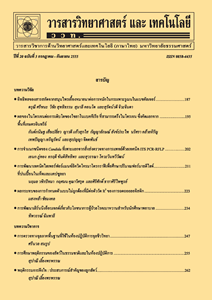การประยุกต์เทคโนโลยีภูมิสารสนเทศเพื่อวิเคราะห์พื้นที่เสี่ยงต่อการเกิดแหล่งเพาะพันธุ์ของแมลงวันหัวเขียว ตำบลแม่ปะ อำเภอแม่สอด จังหวัดตาก
Main Article Content
Abstract
Abstract
The objectives of this study were to analysis risk areas for breeding site of Blow Flies in Maepa subdistric and analysis of spatial relationships between the prevalence of diarrhea and breeding site of blow flies. The study was divided into two parts: (1) to analyze the risk areas for breeding site of blow flies by using ranking and rating method. (2) to analyze of spatial relationships between the prevalence of diarrhea and breeding site of blow flies by using overlay method. Results showed that, risk areas for breeding site of blow flies in highest level have temperature 21.84-23.15 °C relative humidity 70.20-72.58 % have landuse and landcover type of communities and buildup density level of fresh food stalls and public toilets and toilets in households in the most crowded level and garbage dump community in moderate risk areas. Accoding to analysis spatial relationships, the prevalence of diarrhea is positively correlated with the risk areas of breeding site of blow flies the confidence level (R2) 0.8445, using statistical methods. But, no correlation was used to overlay methods. However, this study may be one approach that can be used to study the disease, disease vectors, including the management and control of disease vectors in the future.
Keywords: ranking and rating method; spatial relationships; prevalence of diarrhea; breeding site of blow flies
Article Details
References
[2] คม สุคนธสรรพ์ และกาบแก้ว สุคนธสรรพ์, 2553, แมลงวันหัวเขียวที่มีความสำคัญในราชอาณาจักรไทย, กู๊ด-พริ้นท์ พริ้นท์ติ้ง, เชียงใหม่.
[3] Chaikaew, N., Tripathi, N.K. and Souris, M., 2009, Exploring spatial patterns and hotspots of diarrhea in Chiang Mai, Thailand, Int. J. Health Geograph. 8: 1-10.
[4] Charoenpanyanet, A., 2011, Anopheles Mosquito Density Predictive Model Using Remotely Sensed Data, Lambert Academic Publishing, Düsseldorf.
[5] Santos, C.B., Araújo, K.C.G.M., Jardim-Botelho, A., Santos, M.B., Rodrigues, A., Dolabella, S.S. and Gurgel, R.Q., 2014, Diarrhea incidence and intestinal infections among rotavirus vaccinated infants from a poor area in Brazil: A spatial analysis, BMC Publ. Health 14: 1-8
[6] Department of the Interior U.S. Geological Survey, 2016, LANDSAT 8 (L8) Data Users Handbook Version 2.0, Available Source: https://landsat.usgs.gov/sites/default/files/documents/Landsat8DataUsersHandbook.pdf, March 5, 2017.
[7] กาบแก้ว สุคนธสรรพ์, แมลวัน, แหล่งที่มา : http://www.med.cmu.ac.th/dept/parasite/public/Fly.htm, 2 พฤษภาคม 2560.
[8] Mendoza, G.A., Macoun, P., Prabhu, R., Sukadri, D., Purnomo, H. and Hartanto, H., 1999, Guidelines for Applying Muti-Criteria Analysis to the Assessment of Criteria and Indicators, Center for International Forestry Research (CIFOR), Inc., Indonesia.
[9] Gabre, R.M., Adham, F.K. and Chi, H., 2005, Life table of Chrysomya megacephala (Fabricius) (Diptera: Calliphoridae), Acta Oecologica 27: 179-183.
[10] จักรวาล ชมภูศรี, 2544, แมลงวัน (Files), น. 43-59, ใน อุษาวดี ถาวระ (บรรณาธิการ), ชีววิทยาและการควบคุมแมลงที่เป็นปัญหาสาธารณสุข, สถาบันวิจัยวิทยาศาสตร์สาธารณสุข กรมวิทยาศาสตร์การแพทย์ กระทรวงสาธารณสุข, นนทบุรี.


